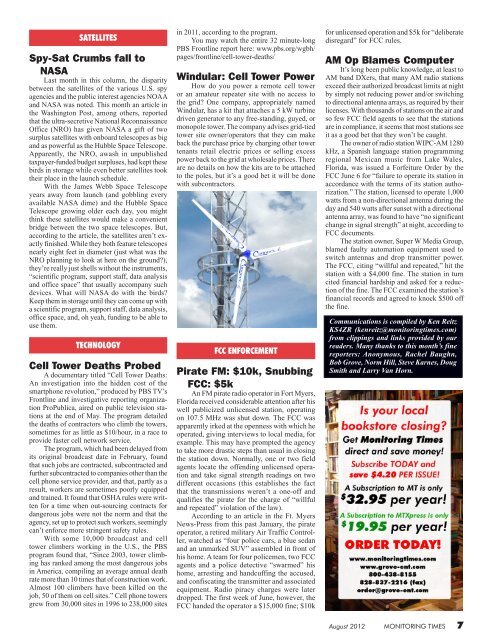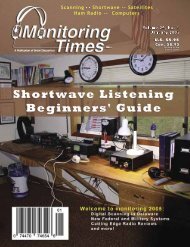RIGHT-click here - Monitoring Times
RIGHT-click here - Monitoring Times
RIGHT-click here - Monitoring Times
You also want an ePaper? Increase the reach of your titles
YUMPU automatically turns print PDFs into web optimized ePapers that Google loves.
SATELLITES<br />
Spy-Sat Crumbs fall to<br />
NASA<br />
Last month in this column, the disparity<br />
between the satellites of the various U.S. spy<br />
agencies and the public interest agencies NOAA<br />
and NASA was noted. This month an article in<br />
the Washington Post, among others, reported<br />
that the ultra-secretive National Reconnaissance<br />
Office (NRO) has given NASA a gift of two<br />
surplus satellites with onboard telescopes as big<br />
and as powerful as the Hubble Space Telescope.<br />
Apparently, the NRO, awash in unpublished<br />
taxpayer-funded budget surpluses, had kept these<br />
birds in storage while even better satellites took<br />
their place in the launch schedule.<br />
With the James Webb Space Telescope<br />
years away from launch (and gobbling every<br />
available NASA dime) and the Hubble Space<br />
Telescope growing older each day, you might<br />
think these satellites would make a convenient<br />
bridge between the two space telescopes. But,<br />
according to the article, the satellites aren’t exactly<br />
finished. While they both feature telescopes<br />
nearly eight feet in diameter (just what was the<br />
NRO planning to look at <strong>here</strong> on the ground?),<br />
they’re really just shells without the instruments,<br />
“scientific program, support staff, data analysis<br />
and office space” that usually accompany such<br />
devices. What will NASA do with the birds?<br />
Keep them in storage until they can come up with<br />
a scientific program, support staff, data analysis,<br />
office space, and, oh yeah, funding to be able to<br />
use them.<br />
TECHNOLOGY<br />
Cell Tower Deaths Probed<br />
A documentary titled “Cell Tower Deaths:<br />
An investigation into the hidden cost of the<br />
smartphone revolution,” produced by PBS TV’s<br />
Frontline and investigative reporting organization<br />
ProPublica, aired on public television stations<br />
at the end of May. The program detailed<br />
the deaths of contractors who climb the towers,<br />
sometimes for as little as $10/hour, in a race to<br />
provide faster cell network service.<br />
The program, which had been delayed from<br />
its original broadcast date in February, found<br />
that such jobs are contracted, subcontracted and<br />
further subcontracted to companies other than the<br />
cell phone service provider, and that, partly as a<br />
result, workers are sometimes poorly equipped<br />
and trained. It found that OSHA rules were written<br />
for a time when out-sourcing contracts for<br />
dangerous jobs were not the norm and that the<br />
agency, set up to protect such workers, seemingly<br />
can’t enforce more stringent safety rules.<br />
With some 10,000 broadcast and cell<br />
tower climbers working in the U.S., the PBS<br />
program found that, “Since 2003, tower climbing<br />
has ranked among the most dangerous jobs<br />
in America, compiling an average annual death<br />
rate more than 10 times that of construction work.<br />
Almost 100 climbers have been killed on the<br />
job, 50 of them on cell sites.” Cell phone towers<br />
grew from 30,000 sites in 1996 to 238,000 sites<br />
in 2011, according to the program.<br />
You may watch the entire 32 minute-long<br />
PBS Frontline report <strong>here</strong>: www.pbs.org/wgbh/<br />
pages/frontline/cell-tower-deaths/<br />
Windular: Cell Tower Power<br />
How do you power a remote cell tower<br />
or an amateur repeater site with no access to<br />
the grid? One company, appropriately named<br />
Windular, has a kit that attaches a 5 kW turbine<br />
driven generator to any free-standing, guyed, or<br />
monopole tower. The company advises grid-tied<br />
tower site owner/operators that they can make<br />
back the purchase price by charging other tower<br />
tenants retail electric prices or selling excess<br />
power back to the grid at wholesale prices. T<strong>here</strong><br />
are no details on how the kits are to be attached<br />
to the poles, but it’s a good bet it will be done<br />
with subcontractors.<br />
FCC ENFORCEMENT<br />
Pirate FM: $10k, Snubbing<br />
FCC: $5k<br />
An FM pirate radio operator in Fort Myers,<br />
Florida received considerable attention after his<br />
well publicized unlicensed station, operating<br />
on 107.5 MHz was shut down. The FCC was<br />
apparently irked at the openness with which he<br />
operated, giving interviews to local media, for<br />
example. This may have prompted the agency<br />
to take more drastic steps than usual in closing<br />
the station down. Normally, one or two field<br />
agents locate the offending unlicensed operation<br />
and take signal strength readings on two<br />
different occasions (this establishes the fact<br />
that the transmissions weren’t a one-off and<br />
qualifies the pirate for the charge of “willful<br />
and repeated” violation of the law).<br />
According to an article in the Ft. Myers<br />
News-Press from this past January, the pirate<br />
operator, a retired military Air Traffic Controller,<br />
watched as “four police cars, a blue sedan<br />
and an unmarked SUV” assembled in front of<br />
his home. A team for four policemen, two FCC<br />
agents and a police detective “swarmed” his<br />
home, arresting and handcuffing the accused,<br />
and confiscating the transmitter and associated<br />
equipment. Radio piracy charges were later<br />
dropped. The first week of June, however, the<br />
FCC handed the operator a $15,000 fine; $10k<br />
for unlicensed operation and $5k for “deliberate<br />
disregard” for FCC rules.<br />
AM Op Blames Computer<br />
It’s long been public knowledge, at least to<br />
AM band DXers, that many AM radio stations<br />
exceed their authorized broadcast limits at night<br />
by simply not reducing power and/or switching<br />
to directional antenna arrays, as required by their<br />
licenses. With thousands of stations on the air and<br />
so few FCC field agents to see that the stations<br />
are in compliance, it seems that most stations see<br />
it as a good bet that they won’t be caught.<br />
The owner of radio station WIPC-AM 1280<br />
kHz, a Spanish language station programming<br />
regional Mexican music from Lake Wales,<br />
Florida, was issued a Forfeiture Order by the<br />
FCC June 6 for “failure to operate its station in<br />
accordance with the terms of its station authorization.”<br />
The station, licensed to operate 1,000<br />
watts from a non-directional antenna during the<br />
day and 540 watts after sunset with a directional<br />
antenna array, was found to have “no significant<br />
change in signal strength” at night, according to<br />
FCC documents.<br />
The station owner, Super W Media Group,<br />
blamed faulty automation equipment used to<br />
switch antennas and drop transmitter power.<br />
The FCC, citing “willful and repeated,” hit the<br />
station with a $4,000 fine. The station in turn<br />
cited financial hardship and asked for a reduction<br />
of the fine. The FCC examined the station’s<br />
financial records and agreed to knock $500 off<br />
the fine.<br />
Communications is compiled by Ken Reitz<br />
KS4ZR (kenreitz@monitoringtimes.com)<br />
from clippings and links provided by our<br />
readers. Many thanks to this month’s fine<br />
reporters: Anonymous, Rachel Baughn,<br />
Bob Grove, Norm Hill, Steve Karnes, Doug<br />
Smith and Larry Van Horn.<br />
August 2012 MONITORING TIMES 7
















